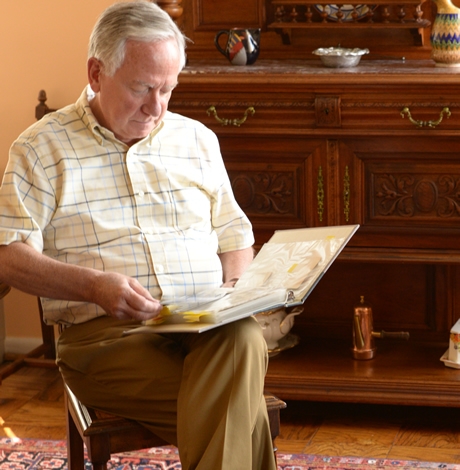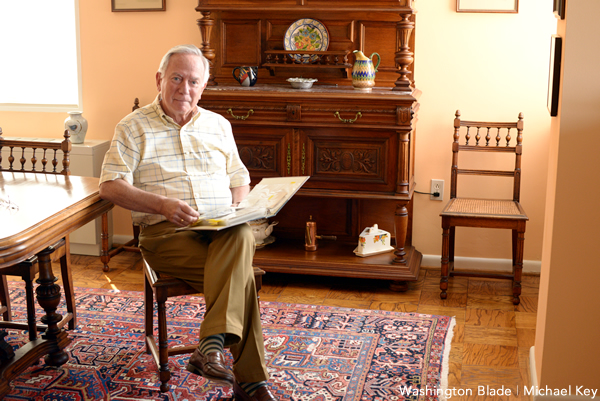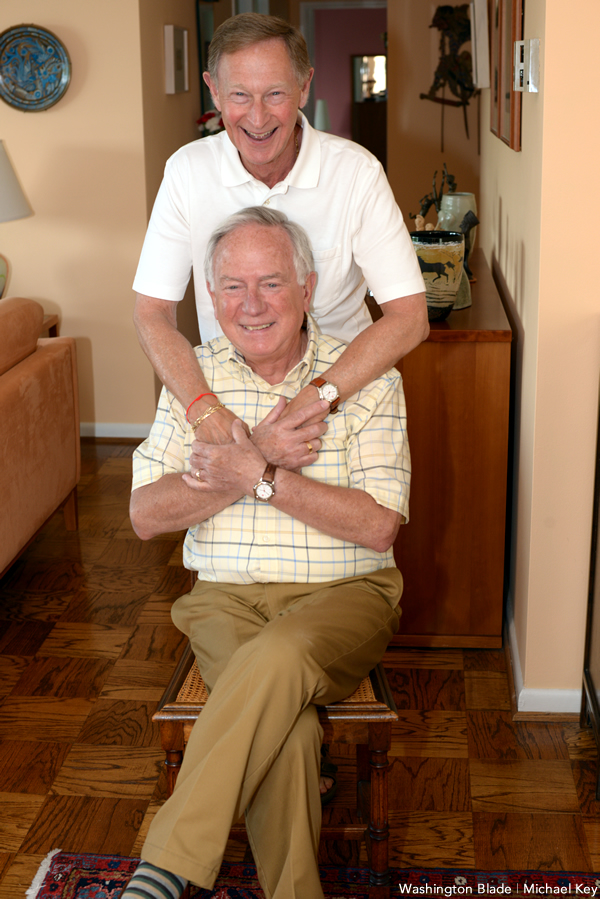a&e features
Gay Holocaust survivor shares life lessons
Alfred Munzer laments ongoing religious, racial hatred


Alfred Munzer in his Van Ness apartment. Now retired from his medical career, Munzer devotes much of his time to the Holocaust Museum. (Washington Blade photo by Michael Key)
First Person 2015 Series: Al Munzer
Conversation with a Holocaust Survivor
Wednesday, July 29
11 a.m.
U.S. Holocaust Memorial Museum
100 Raoul Wallenberg Place, S.W.
Free
No registration required
Although the odds were not favorable for Alfred Munzer in the circumstances surrounding his birth, in many ways, he ended up being the luckiest member of his family.
He’s the youngest of three children of Simcha and Gisele Munzer, a family of Jewish immigrants from what is now Poland. His parents were childhood sweethearts and were raising two daughters, Eva (born in July 1936) and Leah (born in November 1938) in the Hague, Netherlands. After World War I, anti-Semitism was rampant in their native land and opportunities were limited, so they moved to Holland where there was a substantial population of Jews, some of whom were from families that had been there since the 15th century. Simcha ran a men’s tailoring business.
When Gisele discovered she was expecting a third child — the pregnancy was unplanned — an abortion was advised and, as Munzer tells it today, his mother was told that, “it would be immoral to bring another Jewish life into the world.” Although not especially religious, she was inspired by the Old Testament story of Hannah, the childless woman who vows to God that if she is given a son, she will give him back to God. Her wish is granted with the birth of Samuel.
Munzer, now 73, was born on Nov. 23, 1941. Before he reached his first birthday, in July of 1942, Germans began mass deportations of nearly 100,000 Jews from the occupied Netherlands to the east, primarily Auschwitz, a network of Nazi concentration camps in German-annexed regions that had previously been part of Poland. It marked the beginning of a harrowing season for his family.
Munzer says growing up, he was often reminded of the circumstances around which he was born.
“Any time I was bad growing up, my mother would remind me of this, how she had prayed to God and requested a son,” Munzer says. “She indoctrinated me with this. It was made very clear that she had made the same pledge as Hannah and that I was here in service of God ultimately.”
It’s one of many biographical stories Munzer will share on Wednesday, July 29 when he does another installment of the Holocaust Museum’s First Person program in which survivors are interviewed about their life experiences. Since retiring from his career as an internist and pulmonologist last year, Munzer has become increasingly active as a volunteer at the museum. The program is free.
Having shared his life story many times over the years, first at an artistic event in Woodstock, N.Y., in the early 1980s, Munzer says it’s important that his story and those of other Holocaust survivors continue to be told.
“The angle I usually take is that even in a sea of evil, it is possible for people to do the right thing and stand up for what is right,” he says.
Unlike, for instance, the Anne Frank family, the Munzers thought they’d fare better if they went into hiding separately. Munzer’s two sisters went to live with a Catholic family. Simcha Munzer had received a notice to report for so-called labor duty, essentially a one-way ticket to a concentration camp, but was able to delay it by first having a hernia operation he’d been putting off and later faking a suicide attempt. Joined by Gisele at a Jewish psychiatric hospital where she was pretending to be a nurse’s aide, the two were eventually deported, in early 1943, to Vught Concentration Camp and then a year later to Auschwitz where they were separated.
Gisele had sold the family’s possessions. Neighbors kept some items such as a silver candelabra and fire dragon puppet that are now in Munzer’s Van Ness apartment where he’s lived for about 25 years with his husband, Joel Wind. Though only married for a year and a half, the two have been together since they met at Bet Mishpachah, a local LGBT-affirming synagogue where Munzer sometimes preaches, in 1980.
Things quickly turned dark for the family. The husband of the family raising Munzer’s two older sisters turned out to be a Nazi sympathizer. He denounced his wife and the two girls and all three were arrested and sent to the Westerbork transit camp. On Feb. 8, 1944, Eva, 8, and Leah, 6, were deported to Auschwitz where they were killed three days later.
Alfred was put in the care of a family friend named Annie Madna who placed him with her sister. After about a month, she became too nervous to keep him and placed little Alfred with her ex-husband Tole, a native of Indonesia. Munzer stayed there for the next three years and was looked after by their housekeeper, Mima Saina, who went to great lengths to care for him.
“She really became my mother,” Munzer says. “She was a woman who was completely illiterate, who spoke no Dutch, couldn’t read or write, she spoke only Indonesian, but she had a heart of gold. She would walk — I was in the house illegally, so there were no ration coupons for me — she had to scrounge up milk for me however she could, sometimes walking miles just to get it. I’m told I slept in her bed. She kept a knife under the pillow to kill off any Nazis who might try to get me or even kill me rather than having me fall in their hands. She was an amazing woman who raised me from the time I was about 9 months old till I was about 3 and a half.”
Simcha spent several months in Auschwitz and was then sent to three different camps in Austria. Although eventually freed from one in Ebensee in the Austrian Alps by the U.S. Army, he was so weakened by the ordeal that he died under the care of nuns at a convent just two months later, on July 25, 1945, 70 years ago this weekend. Munzer was told his father had contracted tuberculosis.
Gisele fared better and worked on electronics equipment in a series of camps before she was freed at the Danish border through the intervention of the Swedish Red Cross in early 1945. Although fussy from having been awoken from a nap, being reunited with her is one of Munzer’s earliest memories.
“I was cranky and crying so the whole Matna family was passing me around, like you do with a crying baby, and the only lap I wouldn’t sit on was my own mother’s,” Munzer says. “She was a stranger to me by that point.”
It was decided that his de facto surrogate mother Mima would continue to care for him while Gisele looked for work but Mima had a cerebral hemorrhage about two months later and died. Gisele eventually found work in the garment industry. Although deeply traumatized by the Holocaust, Munzer remembers her as a stoic, matter-of-fact woman. He had no sense growing up that his life was any different from anyone else’s.
“I was surrounded by kids who had lost their parents, who had lost siblings, there really was nothing unusual about that,” he says. “I did not understand as a very young kid what had happened to my sisters. All I knew was that there were these beautiful pictures on the wall of these beautiful girls. Everybody would tell me how wonderful they were. One of my mother’s neighbors would tell me that my older sister could write so perfectly when she was just 6. I was a little bit jealous of them in a sense. I had no comprehension of the fact that they had been killed. I just did not understand why they were missing or just didn’t really think about it.”
Neither, too, did the bombed-out landscape of the Hague, strike young Munzer as unusual.
“My mother had a very good friend who was in a concentration camp with her and she and her husband, well, there was very little housing available there. After my mother closed her store, she had acquired a little cosmetics store, we’d go to visit the Van Der Pols in these few little rooms they had in an attic and we’d walk across these huge fields of rubble to get there. I thought walking through rubble was just a normal thing. Or playing hide and seek in bunkers on the beach. It wasn’t until much later that I came to grips with the Holocaust as such.”
In July 1958, Gisele and then-16-year-old Alfred came to the United States where he became a bit of an overachiever. Located in Brooklyn, he finished high school, college, medical school and advance training at Johns Hopkins. He first came to Washington in 1972 during a two-year tour of duty with the Air Force and an assignment at Andrews Air Force Base.
He has many happy memories of his later years with his mother and says the two enjoyed many trips, including a few to visit his father’s grave, in her later years. A pivotal turning point in his understanding of the Holocaust came in 1978 when the miniseries “The Holocaust” aired on CBS.
“Before, I would hear her in conversations with friends and it was always, ‘so-and-so came back’ or ‘so-and-so did not come back.’ They never used the term survived. She had told me little bits and pieces here and there, actually humorous things mostly. She told me once very late in the game, she was actually cast as Adolf Hitler in a play, that type of thing. But she always had an incredibly positive attitude, which I think is really what kept her alive. She even spoke of being in one of those cattle cars and being able to look out and see the beautiful countryside. She said, ‘After the war, we may not have much money, but at least that was not a bad way to travel around and see nature. … After the ‘Holocaust’ miniseries, I took out a map and had her trace the 12 concentration camps she had been through and she told me the approximate dates and things that had happened at each place.”
Munzer says she was “very matter of fact about it.”
She eventually embraced Wind and on later trips introduced he and Alfred as “her two sons.” She settled in Rockville and enjoyed painting and was “not especially anti-German,” Munzer says. “She judged people individually and felt that was important.” Several of her landscapes hang above Munzer’s sofa now. She died at age 95 about 12 years ago.
Munzer started volunteering at the museum about eight years ago. He conducts tours, helps with Dutch-to-English translation work, gives talks to student groups and more. He says he’s delighted that the museum has remained popular and, although a challenge, is often overwhelmed by the number of people who visit, crowds having far surpassed estimates since its 1993 opening.
Museum staff say the stories from survivors are hugely important and valuable.
“One of the most powerful ways people (understand history) is to engage with someone who witnessed it,” says Diane Saltzman, director of survivor affairs. “Holocaust survivors who volunteer at the museum provide that personal connection for our visitors and bring an incomprehensible past alive and add a unique and powerful dimension to the visitors’ experience.”
Munzer is thrilled the staff — he’s the only LGBT survivor volunteer he knows of — has not raised the slightest issue with him being gay. He also says being out during his medical career was also pleasantly uneventful in that regard.
Last week’s conviction of 94-year-old SS sergeant Oskar Groening, an Auschwitz bookkeeper sentenced to four years imprisonment for his role as an accessory to murder in 300,000 deaths, is “awfully late” in Munzer’s opinion.
“Although I do think it’s important for people to be brought to justice.”
Equally important, Munzer says, is that the Holocaust is not forgotten.
“To me one of the greatest tragedies of the Holocaust is not even what happened but the fact that violence continues and especially genocide continues. The world really did not learn its lesson and the slogan ‘never again’ has really not been upheld. The fact that there is still religious hatred and racial hatred is just really, really sad. The re-emergence of anti-Semitism but even more in general, just not recognizing people as part of the common human race.”

Joel Wind (standing) and Alfred Munzer married in 2013 after more than 30 years together. (Washington Blade photo by Michael Key)
a&e features
Queer highlights of the 2026 Critics Choice Awards: Aunt Gladys, that ‘Heated Rivalry’ shoutout and more
Amy Madigan’s win in the supporting actress category puts her in serious contention to win the Oscar for ‘Weapons’

From Chelsea Handler shouting out Heated Rivalry in her opening monologue to Amy Madigan proving that horror performances can (and should) be taken seriously, the Critics Choice Awards provided plenty of iconic moments for queer movie fans to celebrate on the long road to Oscar night.
Handler kicked off the ceremony by recapping the biggest moments in pop culture last year, from Wicked: For Good to Sinners. She also made room to joke about the surprise hit TV sensation on everyone’s minds: “Shoutout to Heated Rivalry. Everyone loves it! Gay men love it, women love it, straight men who say they aren’t gay but work out at Equinox love it!”
The back-to-back wins for Jacob Elordi in Frankenstein and Amy Madigan in Weapons are notable, given the horror bias that awards voters typically have. Aunt Gladys instantly became a pop culture phenomenon within the LGBTQ+ community when Zach Cregger’s hit horror comedy released in August, but the thought that Madigan could be a serious awards contender for such a fun, out-there performance seemed improbable to most months ago. Now, considering the sheer amount of critics’ attention she’s received over the past month, there’s no denying she’s in the running for the Oscar.
“I really wasn’t expecting all of this because I thought people would like the movie, and I thought people would dig Gladys, but you love Gladys! I mean, it’s crazy,” Madigan said during her acceptance speech. “I get [sent] makeup tutorials and paintings. I even got one weird thing about how she’s a sex icon also, which I didn’t go too deep into that one.”
Over on the TV side, Rhea Seehorn won in the incredibly competitive best actress in a drama series category for her acclaimed performance as Carol in Pluribus, beating out the likes of Emmy winner Britt Lower for Severance, Carrie Coon for The White Lotus, and Bella Ramsey for The Last of Us. Pluribus, which was created by Breaking Bad’s showrunner Vince Gilligan, has been celebrated by audiences for its rich exploration of queer trauma and conversion therapy.
Jean Smart was Hack’s only win of the night, as Hannah Einbinder couldn’t repeat her Emmy victory in the supporting actress in a comedy series category against Janelle James, who nabbed a trophy for Abbott Elementary. Hacks lost the best comedy series award to The Studio, as it did at the Emmys in September. And in the limited series category, Erin Doherty repeated her Emmy success in supporting actress, joining in yet another Adolescence awards sweep.
As Oscar fans speculate on what these Critics Choice wins mean for future ceremonies, we have next week’s Golden Globes ceremony to look forward to on Jan. 11.
a&e features
Looking back at the 10 biggest A&E stories of 2025
‘Wicked,’ Lady Gaga’s new era, ‘Sexy’ Bailey and more

Although 2025 was a year marked by countless attacks on trans rights and political setbacks, the year also saw brilliant queer artists continuing to create art. From Cannes and Sundance Award winners now vying for Oscar consideration to pop icons entering new stages of their careers, queer people persevered to tell their stories through different media.
With the state of the world so uncertain, perhaps there’s no more vital time to celebrate our wins, as seen through some of this year’s top pop culture moments. While there’s no collection of 10 stories that fully encompass “the most important” news, here are some events that got the gays going:
10. ‘Mysterious Gaze of the Flamingo’ wins big at Cannes

The Cannes Film Festival has become a crucial start for films hoping to make their way to the Oscars, and first-time director Diego Céspedes won the top Un Certain Regard prize for his intimate western “The Mysterious Gaze of the Flamingo.” The film is set in the ‘80s and is intended as an allegory for the AIDS epidemic. Seeing a film that unpacks vital queer history win one of the most coveted awards at Cannes has been a huge point of pride in the independent filmmaking community.
Since the film bowed at Cannes, it has been selected as Chile’s Oscar entry in the Best International Feature race. Speaking with The Blade during the film’s AFI Fest run in October, Céspedes said: At first, I was kind of scared to have this campaign position in the times that we’re living [in] here. But at the same time, I think the Oscars mean a huge platform — a huge platform for art and politics.”
9. ‘The Last of Us’ returns for an even gayer season 2
While the first season of The Last of Us gave us one of TV’s most heartbreaking queer love stories in the episode “Long, Long Time,” Season 2 doubled down on its commitment to queer storytelling with the blossoming relationship between Ellie (Bella Ramsey) and Dina (Isabela Merced). The show expanded on the pair’s relationship in the original video game, making it perhaps the central dynamic to the entire season. That unfortunately came with more homophobic backlash on the internet, but those who checked out all the episodes saw a tender relationship form amid the show’s post-apocalyptic, often violent backdrop. For their performance, Ramsey was once again nominated for an Emmy, but Merced deserved just as much awards attention.
8. ‘Emilia Pérez’ sparks controversy
Jacques Audiard’s genre-bending trans musical “Emilia Pérez” proved to be an awards season juggernaut this time last year, winning the Golden Globe for Best Musical/Comedy. But when the lead star Karla Sofia Gascón’s racist, sexist, and homophobic old tweets resurfaced, the film’s Oscar campaign became a tough sell, especially after Netflix had tried so hard to sell Emilia Pérez as the “progressive” film to vote for. Mind you, the film had already received significant backlash from LGBTQ+ audiences and the Mexican community for its stereotypical and reductive portrayals, but the Gascón controversy made what was originally just social media backlash impossible to ignore. The only person who seemed to come out of the whole debacle unscathed was Zoe Saldaña, who won the Oscar for Best Supporting Actress over Ariana Grande.
7. ‘Sorry, Baby’ establishes Eva Victor as major talent
Back in January at the Sundance Film Festival, Eva Victor (known by many for her brand of sketch comedy) premiered their directorial debut “Sorry, Baby” to rave reviews, even winning the Waldo Salt Screening Award. Victor shadowed Jane Schoenbrun on the set of “I Saw the TV Glow,” and seeing Victor come into their own and establish such a strong voice immediately made them one of independent cinema’s most exciting new voices. A memorable scene in the film sees the main character, Agnes (played by Victor), struggling to check a box for male or female, just one example of how naturally queerness is woven into the fabric of the story.
Most recently, Victor was nominated for a Golden Globe for her performance in the film, and she’s represented in a category alongside Jennifer Lawrence (“Die My Love”), Jessie Buckley (“Hamnet”), Julia Roberts (“After the Hunt”), Renate Reinsve (“Sentimental Value”) and Tessa Thompson (“Hedda”). The film also received four Independent Spirit Award nominations overall.
6. Paul Reubens comes out in posthumous doc

While Paul Reubens never publicly came out as gay before passing away in 2023, the two-part documentary “Pee-wee as Himself” premiered back in May on HBO Max, giving the legendary comedian a chance to posthumously open up to the world. Directed by Matt Wolf, the documentary explores how Reubens found his alter ego Pee-Wee Herman and why he kept his private life private.
The documentary won an Emmy in the Outstanding Documentary or Nonfiction Special category and remains one of the most critically acclaimed titles of the year with a 100% Rotten Tomatoes score. Also worth noting, the National Geographic documentary Sally told the posthumous coming out story of Sally Ride through the help of her long-time partner, Tam O’Shaughnessy.
5. Lady Gaga releases ‘Mayhem’
Lady Gaga entered a new phase of her musical career with the release of Mayhem, her seventh album to date. From the frenzy-inducing pop hit Abracadabra to the memorable Bruno Mars duet featured on “Die With a Smile,” seeing Gaga return to her roots and make an album for the most die-hard of fans was especially rewarding after the underwhelming film releases of “House of Gucci” and “Joker: Folie à Deux.” Gaga has been touring with The Mayhem Ball since July, her first arena tour since 2018. She even extended her tour into 2026 with more North American dates, so the party isn’t stopping anytime soon. And Gaga is even set to make an appearance next May in “The Devil Wears Prada 2.”
4. Cynthia Erivo, Ariana Grande perform at the Oscars

While “Wicked: For Good” didn’t quite reach the heights of the first film, we will forever have Cynthia Erivo and Ariana Grande’s breathtaking live performance that opened the 97th Academy Awards. The pair sang a rendition of “Over the Rainbow,” “Home,” and “Defying Gravity,” paying proper homage to the original 1939 “Wizard of Oz.” Even non-Wicked fans can’t deny how magical and brilliantly staged this performance was. With both Erivo and Grande up for acting Oscars last year, they’re hoping to repeat success and make history with consecutive nominations. Either way, let’s hope there’s another live performance in the making, especially with two new original songs (The Girl in the Bubble and No Place Like Home) in the mix.
3. Indya Moore speaks out against Ryan Murphy
Indya Moore has consistently used social media as a platform for activism, and in September, posted a 30-minute Instagram live speaking out against “Pose” co-creator Ryan Murphy. Moore claimed that Murphy wasn’t being a true activist for trans people. “Ryan Murphy, we need you to do more. You need to address the racism, the violence, and the targeting of people on your productions, Ryan Murphy. You do need to make sure trans people are paid equally. Yes, Janet did the right thing,” Moore said. Murphy was also back in the headlines this year for the critically panned “All’s Fair” and the controversial “Monster: The Ed Gein Story” starring Laurie Metcalf and Charlie Hunnam.
2. Cole Escola wins Tony for Best Leading Actor
Few pop culture moments this year brought us together more than Cole Escola winning a Tony award for “Oh, Mary!” the Broadway show they created, wrote and starred in (we love a triple threat!) Escola made history by becoming the first nonbinary person to win a Tony in the leading actor category, and seeing them excitedly rush to the stage wearing a Bernadette Peters-inspired gown instantly became a viral social media moment.
The cherry on top of Escola’s major moment is the recent news that they are writing a Miss Piggy movie with Jennifer Lawrence and Emma Stone producing — news that also broke the internet for the better. We cannot wait!
1. Jonathan Bailey makes gay history as ‘Sexiest Man Alive’

The same year as his on-screen roles in blockbusters “Jurassic World Rebirth” and “Wicked: For Good,” Jonathan Bailey made history as the first openly gay man to be named People magazine’s “Sexiest Man Alive.” The fact that it took 40 years for an openly gay man to earn the title is a signifier of how far we still have to go with queer representation, and seeing Bailey celebrated is just one small step in the right direction.
“There’s so many people that want to do brilliant stuff who feel like they can’t,” he told PEOPLE, “and I know the LGBT sector is under immense threat at the moment. So it’s been amazing to meet people who have the expertise and see potential that I could have only dreamed of.” In 2024, Bailey founded the charity titled The Shameless Fund, which raises money for LGBTQ+ organizations.
a&e features
Your guide to D.C.’s queer New Year’s Eve parties
Ring in 2026 with drag, leather, Champagne, and more

With Christmas in the rear view mirror, we can turn our attention to ringing in a much-anticipated New Year with a slew of local LGBTQ parties. Here’s what’s on tap.
Pitchers
This spacious Adams Morgan bar is hosting the “Pitchers’ Perfect New Year’s Eve.” There will be a midnight Champagne toast, the ball drop on the big screens, and no cover, all night long. The bar doesn’t close until 4 a.m., and the kitchen will be open late (though not until close). All five floors will be open for the party, and party favors are promised.
Trade
D.C.’s hottest bar/club combo is leaning into the Shark motif with its NYE party, “Feeding Frenzy.” The party is a “glitterati-infused Naughty-cal New Year’s Even in the Shark Tank, where the boats are churning and the sharks are circling.” Trade also boasts no cover charge, with doors opening at 5 p.m. and the aforementioned Shark Tank opening at 9 p.m.. Four DJs will be spread across the two spaces; midnight hostess is played by Vagenesis and the two sea sirens sensuously calling are Anathema and Justin Williams.
Number Nine
While Trade will have two DJs as part of one party, Number Nine will host two separate parties, one on each floor. The first floor is classic Number Nine, a more casual-style event with the countdown on TVs and a Champagne midnight toast. There will be no cover and doors open at 5 p.m. Upstairs will be hosted by Capital Sapphics for its second annual NYE gathering. Tickets (about $50) include a midnight Champagne toast, curated drink menu, sapphic DJ set by Rijak, and tarot readings by Yooji.
Crush
Crush will kick off NYE with a free drag bingo at 8 p.m. for the early birds. Post-bingo, there will be a cover for the rest of the evening, featuring two DJs. The cover ($20 limited pre-sale that includes line skip until 11 p.m.; $25 at the door after 9 p.m.) includes one free N/A or Crush, a Champagne toast, and party favors (“the legal kind”). More details on Eventbrite.
Bunker
This subterranean lair is hosting a NYE party entitled “Frosted & Fur: Aspen After Dark New Year’s Eve Celebration.” Arriety from Rupaul Season 15 is set to host, with International DJ Alex Lo. Doors open at 9 p.m. and close at 3 p.m.; there is a midnight Champagne toast. Cover is $25, plus an optional $99 all-you-can-drink package.
District Eagle
This leather-focused bar is hosting “Bulge” for its NYE party. Each District Eagle floor will have its own music and vibe. Doors run from 7 p.m.-3 a.m. and cover is $15. There will be a Champagne toast at midnight, as well as drink specials during the event.
Kiki, Shakiki
Kiki and its new sister bar program Shakiki (in the old Shakers space) will have the same type of party on New Year’s Eve. Both bars open their doors at 5 p.m. and stay open until closing time. Both will offer a Champagne toast at midnight. At Kiki, DJ Vodkatrina will play; at Shakiki, it’ll be DJ Alex Love. Kiki keeps the party going on New Year’s Day, opening at 2 p.m., to celebrate Kiki’s fourth anniversary. There will be a drag show at 6 p.m. and an early 2000s dance party 4-8 p.m.
Spark
This bar and its new menu of alcoholic and twin N/A drinks will host a NYE party with music by DJ Emerald Fox. Given this menu, there will be a complimentary toast at midnight, guests can choose either sparkling wine with or without alcohol. No cover, but Spark is also offering optional wristbands at the door for $35 open bar 11 p.m.-1 a.m. (mid-shelf liquor & all NA drinks).
-

 Sponsored4 days ago
Sponsored4 days agoSafer Ways to Pay for Online Performances and Queer Events
-

 District of Columbia3 days ago
District of Columbia3 days agoTwo pioneering gay journalists to speak at Thursday event
-

 Colombia3 days ago
Colombia3 days agoBlade travels to Colombia after U.S. forces seize Maduro in Venezuela
-

 a&e features3 days ago
a&e features3 days agoQueer highlights of the 2026 Critics Choice Awards: Aunt Gladys, that ‘Heated Rivalry’ shoutout and more


















